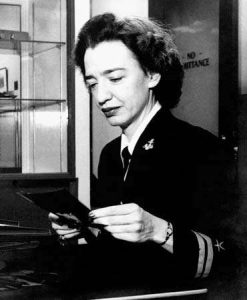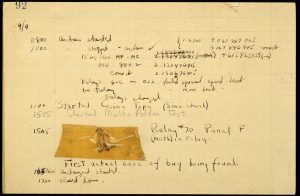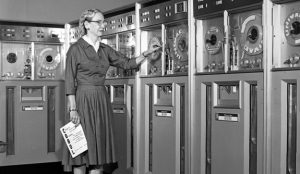Written by: on February 23, 2019

It all started with an alarm clock. Seven-year-old Grace Brewster Murray (Hopper was her married name) wanted to understand how it works, and once the inquisitive little girl set her mind to something, she was unstoppable. So she looked into the matter quite literally, though her mother lost her patience after the seventh dismantled chronograph. However, she never had the intention to clip her daughter’s wings, accordingly, she established one condition: one clock at a time.
The firstborn of Walter Fletcher Murray and Mary Campbell Van Horne was indeed a lucky girl. Her parents firmly believed that their two daughters deserved the same education and opportunities as their son, which was very unusual in the first decades of the twentieth century. Her father, the owner of an insurance company, encouraged Grace not to follow her dreams instead of the customary paths of women. Her mother, being fond of mathematics and logic riddles, taught her eldest to love and understand these beautiful subjects. Grace was allowed to read any book she wanted to satisfy her burning curiosity, which remained her most distinctive trait throughout her life.
At a superficial level, you might suppose that life was easy as pie for Hopper: ideal childhood, getting into college early, joining the navy with full colours and becoming a rear admiral as one of the first ladies at this rank. Honestly, nobody has a life like that; anyone who is really successful is still not able to skip hard work and some failures, they also need determination, willingness, but most of all bravery. As once Hopper said:
“A ship in port is safe, but that is not what ships are for. Sail out to sea and do new things.”
At the age of sixteen, she applied to the famous Vassar College and was rejected because she failed her Latin exam. However, the next year Hopper was accepted, and in 1928 she graduated from Vassar with honours in physics and mathematics. Furthermore, she went on to study maths at Yale on a Vassar fellowship. Two years later she earned her Masters’ Degree, and the following year she was offered a teaching position at Vassar. What’s more, she earned her doctorate in 1934, and after ten years she gained an associate professor position. Had it not been for World War II, she might have stayed at her beloved campus until her retirement.
By 1943 she decided that her countries needed her and she wanted to join the war effort, but she got almost refused again because of her age (being thirty-seven) and her weight (being fifteen pounds short of the minimum). She was determined to join the Navy not only for patriotic reasons but it was her idolised great-grandfather’s branch of service as well. Finally, Hopper’s persistence and the need for good mathematicians for in the military helped her. After some initial training, she was commissioned as a lieutenant, and she was assigned to the Bureau of Ordnance Computation Project at the Harvard University, where she became the third programmer of the world’s first large-scale automatically sequenced digital computer, the Mark I.

After the war Hopper gave up neither her naval nor her computing carrier, she carried on working with the Mark II and III computers. She was at the Harvard when they found an actual bug in a failing part of the machine. A technician retrieved the late moth with the help of tweezers, and then taped it in their logbook. Contrary to the popular belief Hopper’s part was not to create but to popularise the term, and thanks to her ‘’debugging’ became part of the English language.
Wishing to continue working with computers, in 1949 Hopper went to the Eckert-Mauchly Computer Corporation as a senior mathematician. Three years later she created the first compiler for computer languages, which made coding accessible to everyone. Furthermore ‘the queen of software’, as many liked to refer her, developed the COBOL (common business-oriented language) as well, which has been used to make business applications to this day.
At the age of sixty she did what most of her contemporaries did, she retired. However, after only one year she was recalled to serve again for six months in active duty. Eventually, after five years of work, she became a pensioner again. Would you like to bet? Our ‘Amazing Grace’ (another nickname by her admirers) was asked to re-enlist once more the next year. In 1986 she retired for the final time from the navy at the golden age of eighty. In reality, she worked almost till the very last minute of her fruitful life, saying otherwise she would be ‘bored stiff’.

Of course, her accomplishments were awarded many times, for example, Hopper became the first winner of ‘Computer Science Man of the Year’ award from the Data Processing Management Association in 1969. She was the first person from the USA and the first woman from any country to be made Distinguished Fellow of the British Computer Society in 1973, and also the first woman to receive the National Medal of Technology as an individual in 1991. On her last retirement, she was presented with the Defence Distinguished Service Medal, the highest award of the Department of Defence. Moreover, both a Navy destroyer and a Cray supercomputer was named after her.
When ‘grandma COBOL’ was asked which attainment of hers she is proudest of, Hooper revealed:
“The most important thing I’ve accomplished, other than building the compiler, is training young people. They come to me, and say, ‘Do you think we can do this?’ I say, ‘Try it.’ And I back ’em up. They need that. I keep track of them as they get older and I stir ’em up at intervals, so they don’t forget to take chances.”
There was only one thing Grace Hopper despised, the inability of humans to appreciate change, she was tired of all their ‘we’ve always done it this way.’ She said that this was the reason she had a clock on her wall that ran counter-clockwise, and explained it in a widely delivered lecture as the head of the Training and Technology Directorate in the 80s:
“(…) on the first day people meet it, they can’t tell time. On the second day, they discover what used to be 5 of is now 5 after, and they can tell time again. Normally, it’s not till the third day that they suddenly realize: there was never any reason why clocks had to run clockwise.”